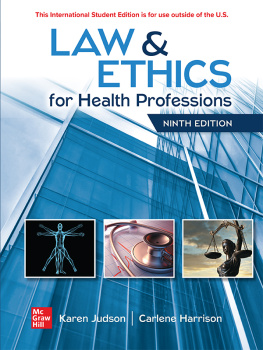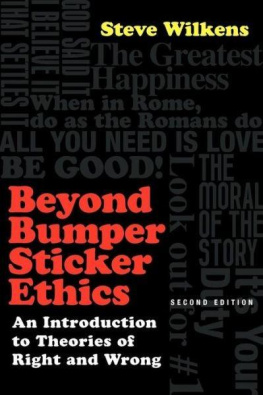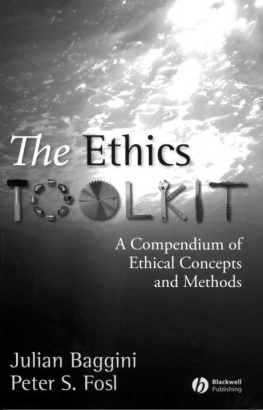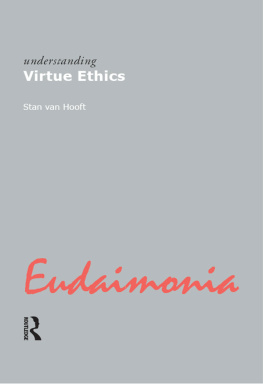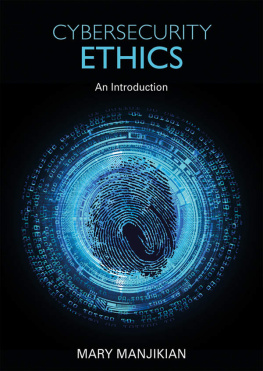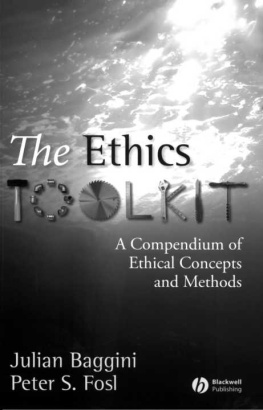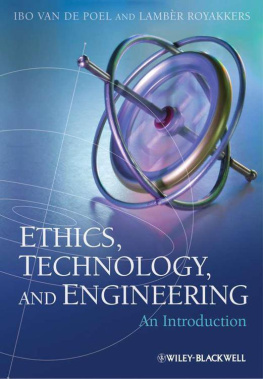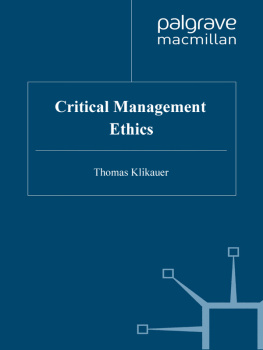
Table of Contents
Guide
Pages
Thomas Whites book introduces the most important ethical theories with relatable examples drawn from student life. This makes it the most engaging introduction to applied ethics there is.
Jussi Suikkanen,
University of Birmingham
One of the best introductory books to practical ethics Ive encountered. Whites Right and Wrong not only distils the subtlest and most complex issues into clear, accessible, but still sophisticated prose. Its also current, not only in terms of philosophical theory but also in the examples he deploys, carefully drawn as they are from real university students struggling with real life.
Peter Fosl,
Transylvania University, Kentucky
This greatly improved and expanded second edition of Right and Wrong introduces students to the major traditions in Western philosophical ethics and provides them with a basic methodology for identifying ethical issues and resolving ethical dilemmas. The cases analyzed throughout have been carefully chosen to reflect the lives of undergraduate studentsthey are all contributed by students, and are taken from major challenges in university life, such as academic dishonesty, partying, and relationships.
As a result of an increased interest in virtue ethics and the ethics of care, these areas now have their own treatment, in addition to the teleological and deontological approaches explored in the original volume. The new edition also features a significant strengthening of the discussion of Kant, and an expanded and revised discussion of utilitarianism. The final chapter applies the methodology developed in the book in an extended analysis of two cases. This not only illustrates how each of the approaches studied can illuminate a unique aspect of a situation, but also demonstrates the way in which students might apply ethical theory to practice in their everyday lives.
Right and Wrong
A Practical Introduction to Ethics
Thomas I. White
Second Edition
This second edition first published 2017
2017 Thomas I. White
Edition history: Pearson (1e, 1988)
Registered Office
John Wiley & Sons, Ltd, The Atrium, Southern Gate, Chichester, West Sussex, PO19 8SQ, UK
Editorial Offices
350 Main Street, Malden, MA 021485020, USA
9600 Garsington Road, Oxford, OX4 2DQ, UK
The Atrium, Southern Gate, Chichester, West Sussex, PO19 8SQ, UK
For details of our global editorial offices, for customer services, and for information about how to apply for permission to reuse the copyright material in this book please see our website at www.wiley.com/wileyblackwell.
The right of Thomas I. White to be identified as the author of this work has been asserted in accordance with the UK Copyright, Designs and Patents Act 1988.
All rights reserved. No part of this publication may be reproduced, stored in a retrieval system, or transmitted, in any form or by any means, electronic, mechanical, photocopying, recording or otherwise, except as permitted by the UK Copyright, Designs and Patents Act 1988, without the prior permission of the publisher.
Wiley also publishes its books in a variety of electronic formats. Some content that appears in print may not be available in electronic books.
Designations used by companies to distinguish their products are often claimed as trademarks. All brand names and product names used in this book are trade names, service marks, trademarks or registered trademarks of their respective owners. The publisher is not associated with any product or vendor mentioned in this book.
Limit of Liability/Disclaimer of Warranty: While the publisher and author have used their best efforts in preparing this book, they make no representations or warranties with respect to the accuracy or completeness of the contents of this book and specifically disclaim any implied warranties of merchantability or fitness for a particular purpose. It is sold on the understanding that the publisher is not engaged in rendering professional services and neither the publisher nor the author shall be liable for damages arising herefrom. If professional advice or other expert assistance is required, the services of a competent professional should be sought.
Library of Congress CataloginginPublication Data
Names: White, Thomas I., author.
Title: Right and wrong : a practical introduction to ethics / Thomas I. White.
Description: Second edition. | Chichester, UK ; Hoboken, NJ : John Wiley & Sons, 2017. | Includes index.
Identifiers: LCCN 2016033866| ISBN 9781119099338 (cloth) | ISBN 9781119099291 (pbk.) | ISBN 9781119099307 (Adobe PDF) | ISBN 9781119099321 (ePUB)
Subjects: LCSH: Ethics.
Classification: LCC BJ1012 .W5 2017 | DDC 170dc23
LC record available at https://lccn.loc.gov/2016033866
A catalogue record for this book is available from the British Library.
Cover image: M.C. Eschers Day and Night 2016 The M.C. Escher Company-The Netherlands. All rights reserved. www.mcescher.com
To Jeff Herman
With admiration and gratitude
Preface
One of the major challenges of writing an applied ethics book is selecting cases. Humans have such a proclivity for behaving badly that there is never a shortage of examples from which to choose. However, because new scandals crop up on virtually a daily basis, cases quickly become dated and obsolete. In this book, I aim to get around that problem by using ethical dilemmas that represent constants in university life. Matters of academic dishonesty, partying, and relationships (more prosaically, sex, drugs, crib, and cheat) are as central to the student experience now as they were in the eleventh and twelfth centuries.
Virtually all of these cases are genuine ethical issues that some student or other faced. They were submitted through a website I created (ethicsoncampus.com) in a way that guaranteed students anonymity. In order to further respect students privacy, any names cited and certain details of the cases have been changed. More cases were submitted than I could use in the book, so I have posted them on the site in case anyone would like to use them in their classes. Ideally, the site can be a useful, ongoing source of cases that reflect ethical issues students currently face. Faculty teaching with this book should feel free to encourage their students to post cases; students are more than welcome to do so on their own.
Because one of the individuals involved in the case decided which facts to report and how to describe the circumstances, it is obviously possible that cases are tilted in favor of the students submitting them. In working with these cases, however, Id encourage taking them at face value so as not to be sidetracked from the ethical issues they contain.
I am grateful to a number of people whose assistance was critical to the success of this project. Jeff Dean (formerly of WileyBlackwell, currently at Harvard University Press), with whom I had worked on my In Defense of Dolphins: The New Moral Frontier, was the initial champion of this book. Liam Cooper and then Marissa Koors subsequently shepherded the project to completion. The anonymous reviewers whom my editors selected provided me with sage guidance. I am especially grateful to two groups of students. First, the students from the variety of colleges and universities who submitted cases. Pride of place, however, goes to the students in my Honors ethics course at Loyola Marymount University who let me test drive an earlier version of this book with them. As always, I depended greatly on the patience and support of my wife, Lisa Cavallaro. Finally, as is recognized in this books dedication, I wish to thank my agent, Jeff Herman, for a partnership of more than thirty years.
Next page


